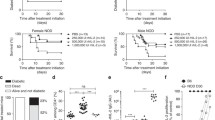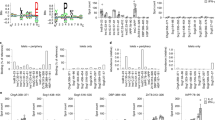Abstract
A solid-phase immunoenzymatic technique with B1- or B29-biotinylated insulin coupled to avidincoated wells was used to characterize serum anti-insulin antibodies and to locate insulin antibody-producing B lymphocytes in different organs of mice. Low natural serum anti-insulin IgM and IgG antibodies were found in ten different healthy inbred strains of mice. Prediabetic nonobese diabetic (NOD) mice had significantly higher measurements than BALB/c mice (P<0.05). Anti-insulin IgM antibody-producing B lymphocytes were found in bone marrow and spleen of NOD mice and healthy strains of mice, but not in peripheral lymph nodes, thymus, blood or pancreas. B29-fixed insulin was more frequently recognized than B1-fixed insulin. There was no relationship to the MHC or to other immune markers. IgG insulin antibody-producing cells were not detected. IgG insulin antibody-producing cells appeared in the draining lymph node and in the blood 10 days after immunization with insulin. IgM insulin-recognizing cells in the spleen were reduced in number during the same period (P<0.05–0.01 for BALB/c, DBA2, B10.D2 and NOD), suggesting migration of these cells. This was tested by in vivo staining of spleens with the red-fluorescent membrane linker PKH-26 on day 7 after immunization. Cells from immunized lymph nodes were FACS-sorted on day 10. Insulin antibody-producing B lymphocytes with red-fluorescence were found, indicating a splenic origin. Examination of IgG subclasses showed preferential production of complement-fixing IgG2b in sera and lymph node cells of immunized NOD mice (P<0.05 vs BALB/c). We conclude that a natural repertoire of insulin recognition exists in bone marrow and spleen of mice. Hydrophobic epitopes around B1 (B29-fixed insulin) are more frequently recognized than hydrophilic epitopes around B29 (B1-fixed insulin), indicating a genetically fixed pattern of autorecognition. Insulin-recognizing cells from the spleen function as the source of insulin antibody response. Preferential occurrence of complement-fixing IgG2b in NOD mice could contribute to autoimmune-mediated β-cell damage.
Similar content being viewed by others
References
Castano L, Eisenbarth GS, Type-I diabetes: a chronic autoimmune disease of human, mouse, and rat. Annu Rev Immunol 8:647–679, 1990
Soeldner JS, Tuttleman M, Srikanta S, Ganda OP, Eisenbarth GS, Insulin dependent diabetes mellitus and initiation of autoimmunity: islet cell autoantibodies, insulin autoantibodies and beta cell failure. N Engl J Med 313:893–894, 1985
Palmer JP, Asplin CM, Clemons P, Lyon K, Iatpati O, Raghu P, Paquette TL, Insulin antibodies in insulin dependent diabetes before insulin treatment. Science 222:1337–1339, 1983
Atkinson MA, Maclaren NK, Riley WJ, Winter WE, Fisk DD, Spillar RP, Are insulin autoantibodies markers for insulin-dependent diabetes mellitus? Diabetes 35:894–898, 1986
Dean BM, Becker E, McNally JM, Torn AC, Schwartz B, Gale EA, Bottazzo GF, Insulin auto-antibodies in the prediabetic period: correlation with islet cell antibodies and development of diabetes. Diabetologia 29:339–342, 1986
Vardi P, Dib SA, Tuttleman M, Connelly JE, Grinbergs M, Rabizadeh A, Riley WJ, Maclaren NK, Eisenbarth GS, Soeldner JS, Competitive insulin autoantibody assay: prospective evaluation of subjects at high risk for development of type I diabetes mellitus. Diabetes 36:1286–1291, 1987
Ziegler AG, Vardi P, Ricker AT, Hattori M, Soeldner JS, Eisenbarth GS, Radioassay determination of insulin autoantibodies in NOD mice. Correlation with increased risk of progression to overt diabetes. Diabetes 38:358–363, 1989
Palmer JP, Insulin autoantibodies: their role in the pathogenesis of IDDM. Diabetes Metab Rev 3:1005–1015, 1987
Petersen KG, Storch MJ, Rother K, Licht T, Kerp L, Insulin and anti-insulin antibody interaction. Evidence for the formation of 7S and 10S structures. Diabetes 34:799–802, 1985
Petersen KG, Schuler G, Hösl W, Storch MJ, Kerp L, Maturation of immune response to insulin. Recruitment of new epitopes by antibodies. Diabetes 35:1321–1325, 1986
Sedgwick JD, Holt PG, A solid-phase immunoenzymatic technique for the enumeration of specific antibody-secreting cells. J Immunol Methods 57:301–309, 1983
Czerkinsky C, Nilsson Lå, Nygren H, Ouchterlony Ö, Tarkowski A, A solid-phase enzyme-linked immunospot (ELISPOT) assay for enumeration of specific antibody-secreting cells. J Immunol Methods 65:109–121, 1983
Gattner HG, Naithani VK, C-terminal carboxyl function (Thr-B30) mediated cross-linking and immobilization of insulin. In: Jung G, Bayer E (eds) Peptides 1988. Walter de Gruyter, New York, pp 262–273, 1989
Johnson EE, Normograph for binomial and poisson significance tests. Industrial Quality Control 15:22–24, 1959
Slezak SE, Schmitt TC, Jensen BD, Huirhead KA, Horan PK, In-vivo applications of a “red” cell-linker compound: assessment of cell function using in-vitro labeling of rabbit RBCs and in-vivo cell growth measurements. Cytometry [Suppl] 4:105, 1990
Schmitt TC, Slezak SE, Jensen BD, Huirhead KA, Horan PK, In-vitro applications of a new “red” cell-linker compound: investigation of cell-linker retention and applications to cell growth and cell mediated cytotoxicity. Cytometry [Suppl] 4:63, 1990
Storch MJ, Licht T, Petersen KG, Obermeier R, Kerp L, Specificity of monoclonal anti-human insulin antibodies. Diabetes 36:1005–1009, 1987
Dighiero G, Lymberi P, Holmberg D, Lundquist I, Coutinho A, Avrameas S, High frequency of natural autoantibodies in normal newborn mice. J Immunol 134:765–771, 1985
Holmberg D, Forsgren S, Forni L, Ivars F, Coutinho A, Idiotypic determinants of natural IgM antibodies that resemble self Ia antigens. Proc Natl Acad Sci USA 81:3175–3179, 1984
Park YH, Osmond DG, Regulation of early precursor B cell proliferation in mouse bone marrow: stimulation by exogenous agents mediated by macrophages in the spleen. Cell Immunol 135:168–183, 1991
Pietrangeli CE, Osmond DG, Regulation of B-lymphocyte production in the bone marrow: mediation of the effects of exogenous stimulants by adoptively transferred spleen cells. Cell Immunol 107:348–357, 1987
Pereira P, Forni L, Larsson EL, Cooper M, Heusser C, Coutinho A, Autonomous activation of B and T cells in antigen-free mice. Eur J Immunol 16:685–688, 1986
Freitas AA, Rocha B, Coutinho AA, Lymphocyte population kinetics in the mouse. In: Müller G (ed) Immunological reviews. Munkspaard, Copenhagen, vol 91: pp 5–37, 1986
Maruyama T, Takei I, Yanagawa T, Takahashi T, Yoshiaki A, Kataoka K, Toshiharu I, Insulin autoantibodies in non-obese diabetic (NOD) mice and streptozotocin-induced diabetic mice. Diabetes Res 7:93–96, 1988
Takei I, Maruyama T, Taniyama M, Kataoka K, Humoral immunity in the NOD mouse. In: Tarui S, Tochino Y, Nonaka K (eds) Insulitis and type 1 diabetes: Lessons from NOD mouse. Academic Press, Tokyo Orlando London, pp 101–110, 1986
Hanafusa T, Miyazaki A, Yamada K, Nakajima H, Miyagawa J, Nonaka K, Tarui S, Tochino Y, Polyendocrine autoantibodies in the NOD mouse (abstract). Folia Endocrinol Jpn 61:447, 1985
Reddy S, Bibby NJ, Elliott RB, Ontogeny of islet cell antibodies, insulin autoantibodies and insulitis in the non-obese diabetic mouse. Diabetologia 31:322–328, 1988
Tsumura H, Komeda H, Yasuhiko I, Shimura K, In vitro and in vivo interferon production in NOD mice. Lab Anim Sci 39:575–578, 1989
Nisonoff A, Hopper JE, Spring SB, The antibody molecule. Academic Press, New York San Francisco London, 1975
Dobersen MJ, Scharff JE, Ginsberg-Fellner F, Notkins AL, Cytotoxic autoantibodies to beta cells in the serum of patients with insulin-dependent diabetes mellitus. N Engl J Med 303: 1493–1498, 1980
Kanatsuna T, Lernmark å, Rubenstein AH, Steiner DF, Block in insulin release from column-perifused pancreatic β-cells induced by islet cell surface antibodies and complement. Diabetes 30:231–234, 1981
Palmer JP, Wilkin TJ, Kurtz AB, Bonifacio E, The third international workshop on the standardisation of insulin autoantibody measurement. Diabetologia 33:60–61, 1990
Dotta F, Wicker L, Peterson L, Pressey A, Appel M, Eisenbarth GS, Inheritance of anti-“polar” antibodies in NOD mice: evidence for a single recessive gene. Diabetes 38:71A, 1989
Author information
Authors and Affiliations
Rights and permissions
About this article
Cite this article
Petersen, K.G., Khalaf, A.N., Naithani, V. et al. Insulin as a target antigen in autoimmune diabetes: a natural repertoire as the source of antibody response. Acta Diabetol 31, 66–72 (1994). https://doi.org/10.1007/BF00570537
Received:
Accepted:
Issue Date:
DOI: https://doi.org/10.1007/BF00570537




